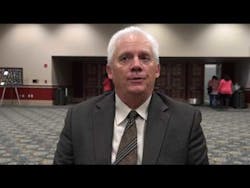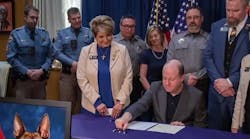The following is an interview with Rich Hendricks. Rich is the former police chief of the Logan Police Department in Logan, Utah, and is the owner of Command Solutions. In this interview, Rich talks about the importance of leadership in the public safety software world today. Command Solutions produces management and executive dashboards for police departments and sheriffs’ offices.
What are the most important factors in creating a great agency?
A great agency takes effort. And it takes vision and direction from the leader – from the top executives. It’s very easy to be an average agency and camouflage yourself. Generally the state of the art technology that officers and the deputies have access to elevates an agency from average to great. And maintaining that level, and sustaining it, takes a strategic plan, specifically for technology.
Why does technology require leadership at an agency?
It’s always changing. It’s a dragon that has to be fed or a black hole that needs attention. The age group of the officers that are being hired now in law enforcement agencies, they’re not afraid of technology. And in years past, that was not always the case. So, executives were hesitant to replace or go out and get new or upgrade or enhance their technology platform. But, today, it’s absolutely essential with the evolvement of society’s needs and the disorder – tracking neighborhoods, understanding the police product that has to be given to each neighborhood, is essential to the success of a law enforcement agency.
In what ways can administrators support the process of incorporating quality technology at their agency?
They’ve got to be involved in the process. They absolutely cannot delegate that responsibility away. They’ve got to go to the demos, they’ve got to be in the committee meetings, they’ve got to see what they’re purchasing, and it has to be more hands on. This is the second most valuable resource in a department, second only to personnel. And it gives you that platform as an executive to build strategic plans, to delegate resources, to understand the police product that each neighborhood and each client needs, and facilitate the vision and mission statement that you’re putting out there for all of your staff.
What are technology committees?
It’s like a user committee within the agency. It’s the committee that monitors and gives formal structure to the technology system that’s in place. It’s what provides decision making and strategic planning and it brings all the members of the department in with a representative so that they understand that there’s patrol and there’s detectives and they don’t isolate one unit against another. There’s a sense of unity and commitment and it formalizes the technology position of the department with policy and procedure and shelf life and replacement and state of the art modules that are available that one person might know about but the rest of the department might not have any information about. So, you always want to look for ways to give structure and to formalize the technology platform and a users’ committee is one of the best ways to do it.
Is it important for agency administrators to be at these meetings?
It’s absolutely important. There needs to be an executive presence in all of this technology process because that filters down through the entire department. Then, everyone understands that it’s not just an IT scenario or it’s not just a detective scenario. That executive is creating the vision and the direction. The strategic planning and all the decisions that come, start with that vision and direction and if the executive has delegated it away or ignored it or put it on the back burner, you can absolutely see that things are falling behind. And if you’re not going forward, you’re going backward. That executive presence helps sustain the formal structure of a technology platform.
In your experience, what obstacles or challenges prevent agency administrators from being as involved in these committees or with technology at their agency as they should be?
For the most part it’s individual. It’s not that they want to ignore it; they’re just not comfortable with it. And the meetings are hard because you don’t understand everything that’s being talked about it. I always used to say, “If they draw a picture of a police car with an antennae on the white board one more time, somebody’s going to be in trouble.” Then you feel like they’re dumbing it down for you because you’re the Chief and you can only play Word on your phone, you know? It’s a personal fear. And they just have to set that aside and realize they’re the executive. They’re not there to be the one who knows everything. They’re there to make sure that the vision is maintained; that everyone knows that we buy technology to produce these outcomes. These are my outcomes. I’m the Chief or the Sheriff and these are my outcomes and the technology that we get has to support that outcome. End users can participate in that by helping the Chief understand what they need, what’s available, how to budget for it and when to replace it. So, it’s an uncomfortable position for the Chief to be in, but he or she has to set that aside so they can bring the best state of the art technology to their department and move from being an average department to a great department.
What other tactics could agencies put in place to ensure that technology keeps its rightful place among administrators’ priorities?
One of the first things, and the thing that I think needs to be addressed immediately, is that there needs to be policy and procedure. We have policy and procedure for everything in public safety and law enforcement. But I would dare say that there are few policy manuals that have a technology section or chapter. They’ve got to take the time to write it; find a good one, copy it, do whatever you have to do. But you formalize a process when you write it, when you memorialize it in writing and you make it a part of your policy and procedures. You set up a users’ committee. You pick people to be on that committee; you give them times and length of time they’ll serve on the committee, how they’ll rotate, and you make the whole thing sustainable with succession plans. All these things help formalize the process and give technology its proper place in the hierarchy of the operations of your organization.
Find this blog entry and more at Spillman Technologies Inc.



